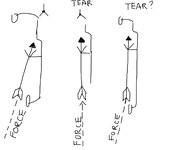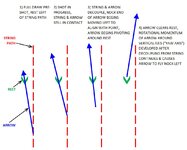Can someone explain the physics and dynamics of paper tuning? I have a persistent nock left tear. I can’t get rid of it by moving the rest to the right. Been there, and I had to move to rest comically right. I can understand how moving the rest can be used to get a bullet hole. I’m trying to understand how the force and direction of the string affects the arrow. For example, if you were to have a string travel that was not parallel with the riser, how does that change the nock travel?
This is difficult to explain with words, but here’s my best shot. If you were to look vertically from the top of the riser to the bottom (looking straight down from the top of the bow), with the rest at center shot, the arrow would be pointing at the 12 o clock position. If you went to full draw and the string travel was perfectly from the 6 o’clock to 12 o’clock position, you would get a bullet hole. Or for that matter, any time the rest is perfectly aligned with the path of string travel, you would get a perfect bullet hole. If the string travel is not perfectly aligned, perhaps traveling from 6:30 to 00:30, but the rest was at the 12 o’clock position, what would be the corresponding result? I drew a janky picture below.
I’m trying to understand how shimming with top hats and changing my grip torque affects my paper tuning so I can make proper adjustments instead of just guessing. It helps if I conceptually understand what is happening with the dynamics of the shot.
I know the picture sucks… but the crayons made a great snack when I was done…
This is difficult to explain with words, but here’s my best shot. If you were to look vertically from the top of the riser to the bottom (looking straight down from the top of the bow), with the rest at center shot, the arrow would be pointing at the 12 o clock position. If you went to full draw and the string travel was perfectly from the 6 o’clock to 12 o’clock position, you would get a bullet hole. Or for that matter, any time the rest is perfectly aligned with the path of string travel, you would get a perfect bullet hole. If the string travel is not perfectly aligned, perhaps traveling from 6:30 to 00:30, but the rest was at the 12 o’clock position, what would be the corresponding result? I drew a janky picture below.
I’m trying to understand how shimming with top hats and changing my grip torque affects my paper tuning so I can make proper adjustments instead of just guessing. It helps if I conceptually understand what is happening with the dynamics of the shot.
I know the picture sucks… but the crayons made a great snack when I was done…


